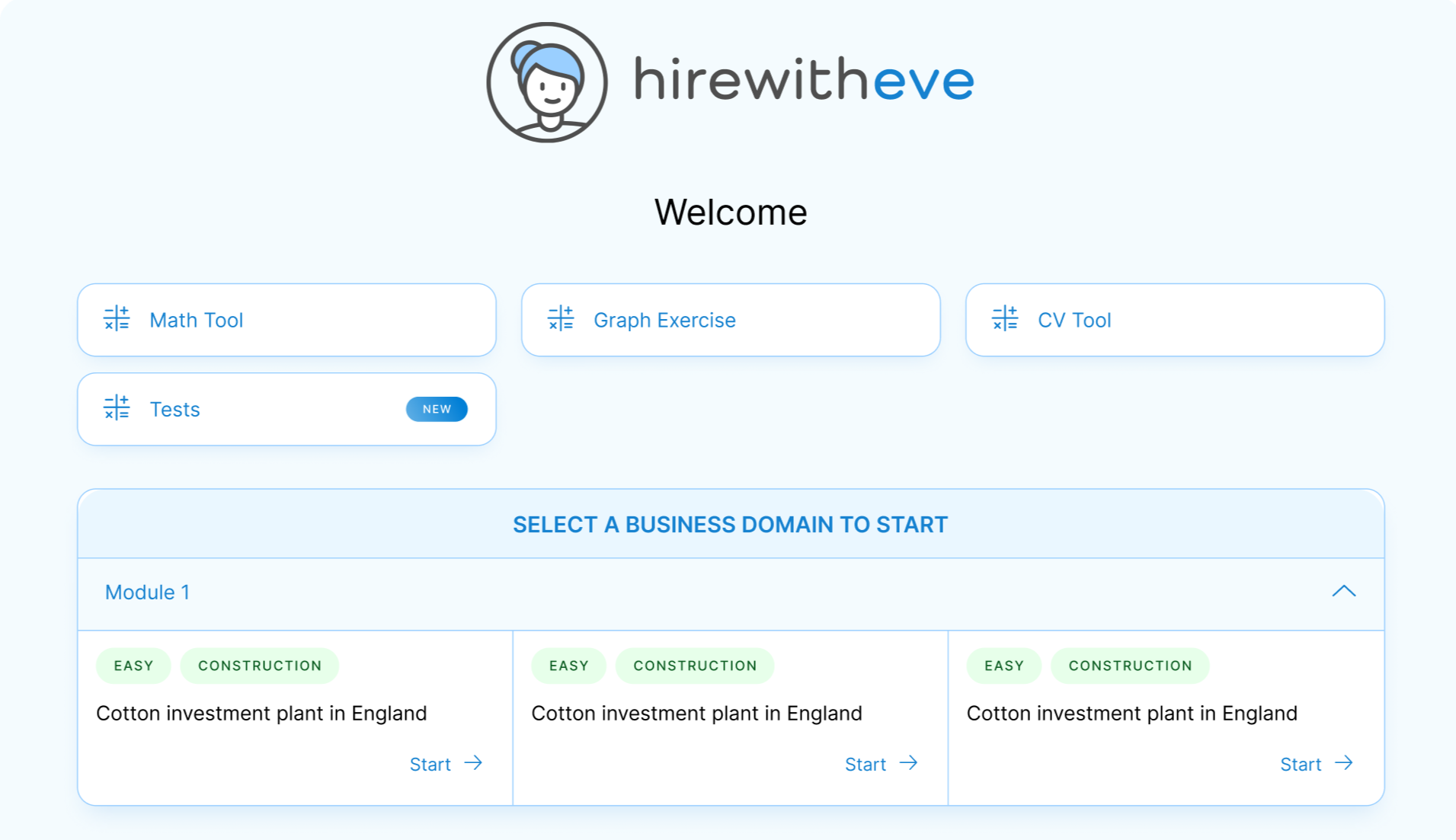Revolutionizing Recruitment: Merit vs. Skills

Share
The world of recruitment is on the cusp of a significant transformation. With increasing scrutiny on fair hiring practices and a growing intolerance for nepotism and bias, companies are under immense pressure to identify top talent while ensuring equal opportunities for all candidates. While many organizations claim to be moving towards a more equitable hiring process, tangible changes are often lacking. College graduates continue to secure top positions over skilled but less privileged candidates. The crux of the issue lies in the distinction between hiring for merit and hiring for skills.
In this comprehensive guide, we will explore the nuances between merit-based and skills-based hiring, highlighting why a skills-based approach is the game-changer your company needs.
We will also introduce you to PracticewithEve, a cutting-edge talent assessment platform designed to streamline and enhance your hiring process.
Table of contents
The Current State of Hiring: Merit vs. Skills
Understanding Merit-Based Hiring
What is Skills-Based Hiring?
Why Skills-Based Hiring is Superior
Implementing Skills-Based Hiring with PracticewithEve
Conclusion
The Current State of Hiring: Merit vs. Skills
As companies strive to enhance their recruitment strategies, the debate between merit-based and skills-based hiring intensifies. Merit-based hiring, while promising on the surface, often fails to address underlying biases and inequalities. On the other hand, skills-based hiring offers a more inclusive and effective approach, focusing on a candidate’s abilities rather than their background.
Understanding Merit-Based Hiring
What Constitutes “Merit”?
Merit-based hiring is a recruitment philosophy that emphasizes selecting candidates based on their proven knowledge, skills, and abilities. This approach aims to move beyond degree-based hiring by considering a broader range of factors to create a more holistic view of a candidate’s qualifications.
Components of Merit
Qualifications: This includes educational credentials such as degrees, certifications, diplomas, or specific training relevant to the position. The goal is to predict whether candidates possess the necessary knowledge for the job.
Work Experience: Employers examine previous employment history, including companies, industries, lengths of service, job titles, and responsibilities. This helps assess the candidate’s hands-on experience with relevant tasks and projects.
Hard and Soft Skills: Tests, case studies, and practical tasks are used to evaluate both technical skills (e.g., programming) and interpersonal skills (e.g., communication, problem-solving).
Notable Achievements: This includes awards, recognitions, academic achievements, and other accolades that demonstrate leadership, determination, and excellence.
Past Performance: Reference checks, performance ratings, and feedback from previous employers are used to gauge a candidate’s work quality, reliability, and work ethic.
The Merit-Based Hiring Process
Job Analysis: Identifying gaps in the workforce and determining the positions that need to be filled.
Role Description and Posting: Listing specific qualifications, experience, and skills required for the job and posting this information on job boards or the company’s website.
Application Screening: Review resumes, cover letters, and application forms to identify candidates who meet the role requirements.
Assessments: Using case studies, practical tasks, and tests to evaluate candidates’ hard and soft skills.
Interviews: Conduct multiple rounds of interviews, including phone calls, technical assessments, motivational interviews, competency-based sessions, and culture-fit evaluations.
Reference Checks: Contact previous employers to verify past performance and behavior.
Decision-Making: Selecting the top candidate based on resumes, assessment scores, and interview feedback.
Job Offer: Issuing a job offer, negotiating terms, setting a start date, and signing the contract.
Background Checks: Verifying candidates’ credentials, experiences, and right to work in the country.
Onboarding: Introducing new hires to the company culture, and team members, and training them for their new roles.
What is Skills-Based Hiring?
Skills-based hiring focuses on selecting candidates based on their existing skills and abilities, rather than their educational background or past experiences. This approach prioritizes a candidate's competencies and potential to perform in a specific role, providing a fairer and more effective hiring process.
The Components of a Skills-Based Approach
Technical Skills: The specific hard skills necessary for the job, such as financial modeling for financial analysts. These skills determine the candidate’s ability to perform daily duties effectively.
Role-Specific Knowledge: Understanding the technical terms, processes, and standards required for the role, including industry-related information and knowledge about the company’s market and offerings.
Soft Skills and Situational Judgment: Assessing candidate's interpersonal skills, decision-making abilities, and how they handle real-world scenarios. This includes organization, time management, and teamwork.
Cognitive Skills: Evaluating how candidates think and process information, including numerical reasoning, reading comprehension, problem-solving, and critical thinking.
Personality Traits: Ensuring the candidate has the right traits and behaviors for the job and fits well with the team. For example, a salesperson needs to be patient, persuasive, and collaborative.
Cultural Chemistry: Assessing how well a candidate aligns with the company’s culture, values, and ethics, and their ability to contribute to and enhance the workplace.
Motivation: Understanding the candidate’s passion for the industry or role and their expectations around pay, benefits, and career development.
The Skills-Based Hiring Process
Skills Analysis: Collaborating with talent acquisition to review the company’s existing skill sets and identify any skill gaps that must be addressed.
Skills-Based Job Descriptions and Posting: Writing role descriptions that focus on the necessary skills and competencies rather than educational degrees or years of experience. Posting these descriptions on traditional and skills-based job boards.
Skills Assessments: Using simulations, practical tasks, and online assessments to evaluate candidates’ hard and soft skills, situational judgment, cognitive abilities, personality traits, cultural fit, and more.
Behavioral Interviews: Conducting in-person or virtual interviews with a fixed set of questions designed to explore candidate's behaviors and real-world experiences.
Decision-Making: Selecting the best candidate based on their assessment scores and interview feedback.
Job Offer: Creating a job offer based on the candidate’s motivation and expectations, negotiating terms, and signing the paperwork.
Background Checks: Conduct checks to ensure honesty in responses rather than penalizing candidates for past issues.
Onboarding: Introducing new hires to their teams and workplaces, ensuring they are familiar with the company culture.
Why Skills-Based Hiring is Superior
While both merit-based and skills-based hiring aim to select quality talent relatively, skills-based hiring is generally superior. Here’s why:
Rooted in Facts, Not Assumptions
In merit-based hiring, resumes, cover letters, and application forms are reviewed before candidates are put through skills tests. This reliance on unverified information can lead to progressing unskilled candidates or rejecting top talent prematurely. In contrast, skills-based hiring uses talent assessments as the first step, providing objective data on candidates’ abilities.
Better Access to Talent
Merit-based practices often limit the talent pool by focusing on degrees and years of experience. Skills-based hiring, however, eliminates these requirements, opening the door to a wider range of candidates, including those skilled through alternative routes.
Reducing Biases
Merit-based hiring is prone to unconscious biases, such as confirmation bias, halo bias, and similarity bias. Skills-based hiring, by focusing on objective evidence and eliminating resumes and reference checks, reduces these biases and promotes fairer decision-making.
Enhancing Diversity
Skills-based hiring increases the likelihood of capturing diverse talent by focusing on skills rather than educational or socioeconomic backgrounds. This approach ensures that candidates are evaluated based on their abilities, leading to a more inclusive workforce.
Future-Relevance of Skills
With the rapid pace of technological change, many of today’s skills will be obsolete shortly. Skills-based hiring prioritizes cognitive skills and personality traits that are more adaptable to changing job requirements, ensuring that your workforce remains relevant and capable.
Candidate Preferences
Candidates prefer a hiring process that focuses on their skills over their education and experience. Skills-based hiring provides a better candidate experience and increases the likelihood of candidates securing their dream jobs.
Implementing Skills-Based Hiring with PracticewithEve
Features and Benefits of PracticewithEve
PracticewithEve is a powerful talent assessment platform designed to help companies implement skills-based hiring effectively. Key features include:
Comprehensive Assessments: Evaluate the candidate's hard and soft skills, situational judgment, cognitive abilities, personality traits, and cultural fit.
Customizable Job Descriptions: Create job descriptions that focus on the necessary skills and competencies.
Objective Data: Use data-driven assessments to make informed hiring decisions, reducing the reliance on unverified information.
Bias Reduction: Eliminate resumes and reference checks to reduce unconscious biases and promote fairer hiring practices.
Enhanced Diversity: Increase the likelihood of capturing diverse talent by focusing on skills rather than backgrounds.
Conclusion
As the recruitment landscape continues to evolve, companies must adopt more inclusive and effective hiring practices. Skills-based hiring offers a superior approach by focusing on candidates’ abilities rather than their backgrounds. By implementing a skills-based hiring process with PracticewithEve, your company can make evidence-based decisions, reduce biases, and enhance diversity, ultimately leading to a more capable and innovative workforce. Embrace the future of recruitment with skills-based hiring and PracticewithEve, and ensure that your company remains at the forefront of fair and effective talent acquisition.
The best advice in pre- employment testing, in your inbox.
No spam. Unsubscribe at any time.
TARGET YOUR TALENT
Unlock tailored solutions for your recruitment and hiring needs with Eve Platform's extensive case study library.
Free Resources

Transforming Hiring: 7 Key Recruiting Metrics
Enhancing recruitment processes with data-driven insights for better hiring outcomes.

Reducing Hiring Bias with Practicewitheve.
Utilizing Practicewitheve to combat bias and streamline recruitment processes effectively.

Hiring Detail-Oriented Candidates
PracticewithEve enhances hiring by accurately assessing candidate's attention to detail-oriented.








